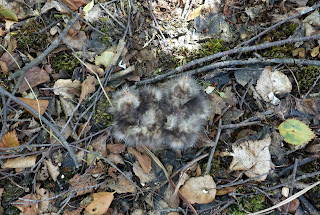Junes Squacco Heron remained around the area for the start
of July, and I occasionally spotted it as it flew between the various water
bodies that compose the triangle and the wetlands. Birding was generally pretty
slow for the most part during the start of the month, with very few birds
turning up in the nets. A young Great-spotted Woodpecker was the best we
managed in the net, and we also finished off the Barn Owl chicks and ringed an
unwell Guillemot that we had been tasked with restoring to health. We also targeted
the Marsh Warblers on Beacon Lane and caught the male bird, but obviously had
to remain quiet as a result of the breeding attempt. The birds fledged three
chicks, making it a very successful breeding attempt. An impressive arrival of
Silver-Y moths was a none avian highlight, with any flowering bush covered in
them.
-Squacco Heron
-Marsh Warbler
The month really kicked off on the 14th when a
Greater Sand Plover was found on the beach at Beacon Ponds. Sadly I was at work
when it was discovered, and when I clocked off it was already dark. Given that
waders at Spurn usual make a swift exit from the area I was not optimistic of
it still being around. The following morning the bird was rediscovered in the
same place, but sadly I was not at Spurn until late morning after which the
bird had disappeared. Of course the damn this reappeared once I started my
shift and was unable to twitch it. I managed to negotiate a half an hour break
mid-afternoon to finally see it, much to my relief.
On the 19th we ringed the Sparrowhawk chicks in
the nest behind the pub, but ringing was otherwise very quiet until the 23rd
when we started using Corner Field. On our first day we managed an impressive
56 birds of 11 species including; 28 Swallows, 2 House Martins and a few Sand
Martins. Sadly the nets never really reached this kind of numbers again as when
we opened them, but we still caught a few nice birds there.
On the 25th the highlight of the month was
discovered down the canal; a cracking male Southern Migrant Hawker. I was away
for most of the day twitching Franklin’s Gull, and when the news broke that a
SMH had been seen at Spurn it very much took the glamour of the twitch away.
The journey back was filled with suspense but fortunately the dragonfly
remained in the same location for the whole day and the following days, so I
was able to see it and really appreciate this stunning rare insect.
-Southern Migrant Hawker
-Emerald Damselfly
On the 27th July, whilst hungover as hell early
morning, news filtered through of a probable Semipalmated Sandpiper on
wetlands. It took a while for everyone to be satisfied with the identification
of the bird, but it showed fairly well allowing for good photos to be taken. It
was a really smart little wader, and a nice end to the month.
-Semipalmated Sandpiper
Ringing remained slow at the end of the month but a couple
of Stock Dove pulli were a nice addition to the Spurn ringing yearlist.
Species List:
Spurn Bird Observatory: Greylag Goose, Mute
Swan, Shelduck, Gadwall, Wigeon, Mallard, Teal, Tufted Duck, Pheasant, Little
Grebe, Grey Heron, Squacco Heron, Little Egret, Gannet, Cormorant, Peregrine,
Kestrel, Sparrowhawk, Marsh Harrier, Buzzard, Moorhen, Coot, Oystercatcher,
Avocet, Lapwing, Grey Plover, Golden Plover, Ringed Plover, Greater Sand
Plover, Whimbrel, Curlew, Dunlin, Redshank, Greenshank, Semipalmated Sandpiper,
Green Sandpiper, Black-headed Gull, Common Gull, Great Black-backed Gull,
Herring Gull, Lesser Black-backed Gull, Sandwich Tern, Little Tern, Common
Tern, Feral Pigeon, Stock Dove, Woodpigeon, Collard Dove, Cuckoo, Swift, Barn
Owl, Little Owl, Magpie, Carrion Crow, Blue Tit, Great Tit, Skylark, Sand
Martin, Swallow, House Martin, Chiffchaff, Sedge Warbler, Reed Warbler, Marsh
Warbler, Blackcap, Lesser Whitethroat, Whitethroat, Wren, Starling, Blackbird,
Song Thrush, Spotted Flycatcher, Robin, Wheatear, House Sparrow, Tree Sparrow,
Dunnock, Yellow Wagtail, Pied Wagtail, Meadow Pipit, Chaffinch, Greenfinch,
Linnet, Goldfinch, Yellowhammer, Reed Bunting,















